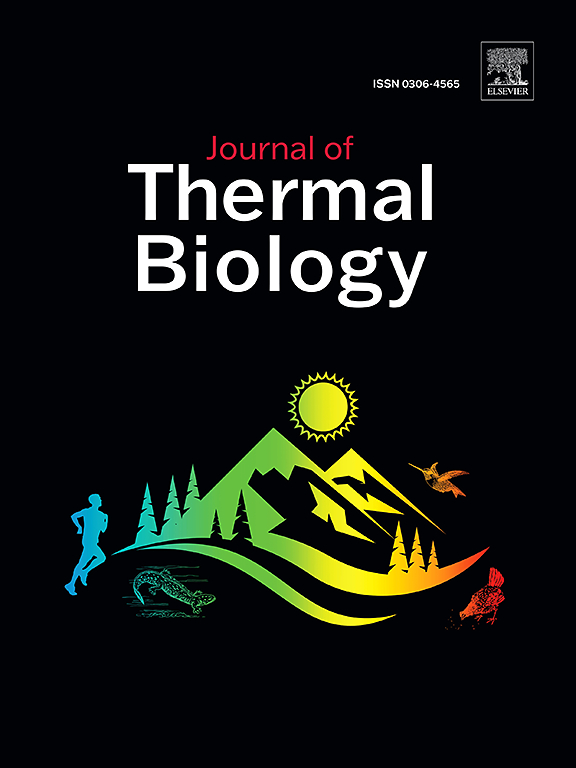在温暖环境条件下进行真实世界长时间步行运动时估计核心温度算法的有效性。
IF 2.9
2区 生物学
Q2 BIOLOGY
引用次数: 0
摘要
背景:估计核心体温(TC)的无创方法越来越多。我们研究了在温暖环境条件下进行真实世界长时间步行运动时,根据连续心率(HR)测量结果估算核心体温(ECTemp™)算法在群体和个体参与者层面的有效性:方法:参与者以自选速度步行 30(n = 3)、40(n = 13)或 50(n = 2)公里,期间每分钟使用可摄入体温胶囊测量一次体温。每秒测量一次心率,并使用 ECTemp™ 算法计算估计核心温度(TC-est)。为评估 TC 和 TC-est 之间的一致性,进行了 Bland-Altman 分析。系统性偏差 结果:18 名参与者(56 ± 16 岁,11 名男性)行走了 549 分钟(418-645 分钟不等),环境温度从 22 °C 升至 29 °C。平均心率为 108 ± 13 bpm,TC 范围为 36.9 至 39.2 °C,TC-est 范围为 36.8 至 38.9 °C(n = 8572 个观测值)。组级数据显示系统偏差为 0.09 °C(p C),TC-est(r = 0.28;p 结论:ECT 和 TC-est 的系统偏差为 0.09 °C(p C):组级数据显示,在温暖环境条件下进行长时间步行运动时,ECTemp™ 算法具有可接受的系统偏差,但 18 名参与者中只有 3 人具有可接受的系统偏差。未来的研究需要提高该算法的准确性,才能让个人用户在实际运动中依赖其估计的血压。本文章由计算机程序翻译,如有差异,请以英文原文为准。
Validity of the estimated core temperature algorithm during real-world prolonged walking exercise under warm ambient conditions
Background
Non-invasive methods to estimate core body temperature (TC) are increasingly available. We examined the group-level and individual participant-level validity of the Estimated Core Temperature (ECTemp™) algorithm to estimate TC based on sequential heart rate (HR) measurements during real-world prolonged walking exercise in warm ambient conditions.
Methods
Participants walked 30 (n = 3), 40 (n = 13) or 50 (n = 2) km on a self-selected pace during which TC was measured every minute using an ingestible temperature capsule. HR was measured every second and used to compute the estimated core temperature (TC-est) using the ECTemp™ algorithm. Bland-Altman analyses were performed to assess agreement between TC and TC-est. A systematic bias <0.1 °C was considered acceptable.
Results
18 participants (56 ± 16 years, 11 males) walked for 549 min (range 418–645 min), while ambient temperature increased from 22 °C to 29 °C. Average HR was 108 ± 13 bpm and TC ranged from 36.9 to 39.2 °C, whereas TC-est ranged from 36.8 to 38.9 °C (n = 8572 observations). Group level data revealed a systematic bias of 0.09 °C (p < 0.001) with limits of agreements of ±0.44 °C. A weak correlation was found between TC and TC-est (r = 0.28; p < 0.001). Large inter-individual differences in bias (range −0.45 °C to 0.62 °C) and correlation coefficients (range −0.09 to 0.95) were found, while only 3 participants (17%) had an acceptable systemic bias of <0.1 °C.
Conclusion
Group level data showed that the ECTemp™ algorithm had an acceptable systematic bias during prolonged walking exercise in warm ambient conditions, but only 3 out of 18 participants had an acceptable systemic bias. Future studies are needed to improve the accuracy of the algorithm before individual users can rely on their estimated TC during real-world exercise.
求助全文
通过发布文献求助,成功后即可免费获取论文全文。
去求助
来源期刊

Journal of thermal biology
生物-动物学
CiteScore
5.30
自引率
7.40%
发文量
196
审稿时长
14.5 weeks
期刊介绍:
The Journal of Thermal Biology publishes articles that advance our knowledge on the ways and mechanisms through which temperature affects man and animals. This includes studies of their responses to these effects and on the ecological consequences. Directly relevant to this theme are:
• The mechanisms of thermal limitation, heat and cold injury, and the resistance of organisms to extremes of temperature
• The mechanisms involved in acclimation, acclimatization and evolutionary adaptation to temperature
• Mechanisms underlying the patterns of hibernation, torpor, dormancy, aestivation and diapause
• Effects of temperature on reproduction and development, growth, ageing and life-span
• Studies on modelling heat transfer between organisms and their environment
• The contributions of temperature to effects of climate change on animal species and man
• Studies of conservation biology and physiology related to temperature
• Behavioural and physiological regulation of body temperature including its pathophysiology and fever
• Medical applications of hypo- and hyperthermia
Article types:
• Original articles
• Review articles
 求助内容:
求助内容: 应助结果提醒方式:
应助结果提醒方式:


